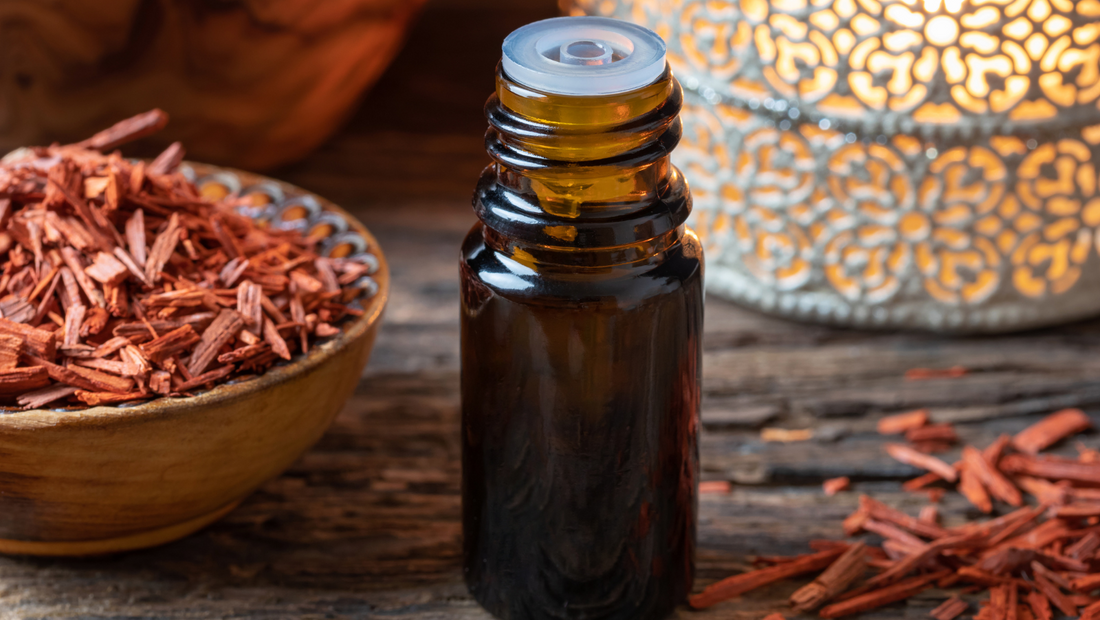
Sandalwood Oil
Share
Sandalwood Oil
Commonly used in sacred ceremonies, aromatherapeutic practices and meditation, the smell of sandalwood is popular around the world!
Sandalwood has a soft, woody aroma. There are many different varieties of sandalwood, but the two we typically use for our body butters include East Indian Sandalwood (Santalum album) - sometimes referred to as “chandan” and SAO, and Australian Sandalwood (Santalum spicatum). Of these two sandalwoods, S. album produces the higher concentrations of both alpha- and beta-santalol (a type of terpene which gives it the familiar “sandalwood smell”). Both sandalwood oils are 100% pure and are extracted from sandalwood chips by steam distillation.
Fun fact: The main genus of sandalwood, Santalum, belongs to the mistletoe family.
Reduces Hyperpigmentation
Alpha-santalol was found to be a key inhibitor for an enzyme responsible for hyperpigmentation of the skin (tyrosinase). This makes SAO useful for lightening skin dark spots due to hyperpigmentation from aging or exposure to UV light.
Anti-Inflammatory
S. album oil (SAO) has been shown to inhibit the oxidative enzyme 5-lipoxygenase (5-LOX), which catalyzes two steps in the biosynthesis of leukotrienes (lipid mediators of inflammation derived from arachidonic acid). This means SAO has been shown to have anti-inflammatory properties by inhibiting an enzyme that leads to inflammation.
The oil has suppressed the production of other proinflammatory substances as well (chemokines and cytokines), and reduced irritant dermatitis in inflamed mouse skin.
Due to its anti-inflammatory effects, SAO has proven to be quite beneficial in the treatment of psoriasis and atopic dermatitis.
Antimicrobial
SAO has also been found to have broad-spectrum activity against many gram-positive strains of bacteria such as Staphylococcus (including both MRSA and VRSA), Streptococcus, and Propionibacterium acne (bacteria that causes acne), as well as some gram-negative bacteria. SAO has also demonstrated activity against some fungal dermatophytes (fungus that can cause skin diseases) and yeasts including Trycophyton, Microsporum, and Candida. Also active against Herpes simplex viruses 1 and 2, this antimicrobial activity could make it a useful tool in fighting against some skin infections!
Antioxidant
SAO has some DPPH scavenging activity. There are many methods used to measure antioxidant effect and DPPH (1,1-diphenyl-2-picrylhydrazil) removal is one of the most popular methods used to determine antioxidant ability. The radical scavenging activity of antioxidants is one of the most important mechanisms for protecting against cell damage caused by free radicals. Cell damage caused by free radicals can accelerate the aging process, cause tissue damage and play an important role in the development of diseases such as certain cancers, acute inflammation, and more. Antioxidants donate electrons to free radicals, which in turn makes them harmless. They also prevent free radicals from forming in the first place by interfering with their 3-step formation process.
Other benefits may include:
- Activity against acne, psoriasis, eczema and rosacea
- Anti-aging
- Heals blemishes and scars
- Smooths skin
- Reduces sunburn
- Conditions and moisturizes both dry skin and hair
- Cleanses scalp, reduces dandruff and promotes faster hair growth
- Softer, shinier hair
Aromatherapeutic Aspects of Sandalwood Oil
- Induces calmness of the mind
- Lowers stress level
- Better quality of sleep
- Improves mood and attentiveness
- Great for meditation
- Helps with depression
- Can create a sensual mood
Important Note: A sandalwood tree must be 15 years or older to produce the aromatic oils and fragrant wood it’s known and loved for. Harvesting the trees needed to make sandalwood oil is difficult, resulting in a high price for genuine sandalwood oil.
A popular ingredient in both Ayurveda and Traditional Chinese Medicine (TCM), sandalwood has been used for many different ailments including but not limited to:
- The common cold
- Urinary tract infections
- Blood disorders
- Liver and gallbladder problems
**We are not suggesting consuming sandalwood oil**
If you would like to see a detailed analysis of SAO and its antimicrobial activity, as well as anti-cancer effects, please check out this article!
There are also several studies listed on clinicaltrials.gov, both ongoing and completed, trialing the use of SAO on other skin conditions such as common warts (Verruca vulgaris), water warts (Molluscum contagiosum), genital warts, psoriasis, oral mucositis, and more.
Thanks for reading. We hope you enjoyed this article on one of our favorite oils. Did you know about all the uses of sandalwood oil? Do you know of any other uses that we did not list? Leave a comment and let us know!
**This website is for information purposes only. By providing the information contained herein we are not diagnosing, treating, curing, mitigating, or preventing any type of disease or medical condition. Before beginning any type of natural, integrative or conventional treatment regimen, it is advisable to seek the advice of your primary care physician.**

1 comentario
Very informative and scholarly! I learned a lot just in the reading, I will definitely use this. You seem to have years of experience in skin care products. I will definitely tell my friends business associates to give you a try. Thank you.